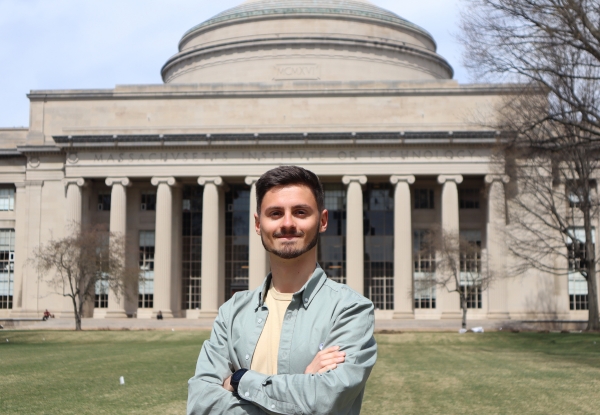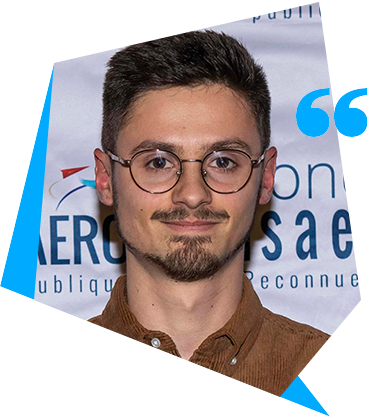< back to articles
3 months of research at MIT for Bastien
Published on
After a few months’ postponement, Bastien was finally able to fly to the United States for a research stay with the MSEAS team in the Mechanics Department of the Massachusetts Institute of Technology (MIT), thanks to support from the Foundation.
He tells you all about his stay.

What motivated you to go to MIT?
I spent a research period with the MSEAS team in the Mechanics Department at the Massachusetts Institute of Technology (MIT), under the supervision of Professor Pierre Lermusiaux, working on the problem of optimal trajectory planning for aerial and underwater drones.
My stay at MIT was part of the scientific continuity of my thesis. The MSEAS team is at the cutting edge of trajectory optimization for underwater drones. In my thesis, I’m interested in optimizing the trajectories of aerial drones over long distances, a problem that has the same mathematical structure as the routing problem for underwater drones. So it was with the ambition of learning more about the routing methods implemented by the MSEAS team that I began my mobility. I was also interested in the cross-fertilization of knowledge between the aeronautical and underwater worlds. In particular, the method for calculating optimal trajectories that I developed in my thesis differs from that proposed by the MSEAS team. An important scientific question was therefore to identify the differences between the two methods, and to determine when one method is more suitable (more effective) than the other. Generally speaking, there seemed to be no connection between the ocean and atmosphere applications of drone routing, and so this mobility was an opportunity to make this useful link to the scientific community.
What’s more, the prospect of discovering the American academic world was of great interest to me. Whatever my future career path, I know I want to keep a connection with the world of research. So it seemed important to me to see the world of American research with my own eyes; better still, to experience it on a daily basis for a few months. This mobility also takes the form of personal revenge: I saw my 6-month internship at the Stanford Research Institute cancelled 3 years ago because of the pandemic… so it was my first professional and academic experience in the United States.
Finally, the prospect of a stay in the USA was also an opportunity for me to practice English intensively, both professionally and personally.
From a scientific point of view, what did you get out of your stay?
Bastien Schnitzler

All in all, my stay was a very productive one from a scientific point of view. I exchanged a lot with Pr. Lermusiaux, who gave me all the time I needed to make my stay a success, as well as with the students and researchers on the team.
At the beginning of my stay, we identified four possible topics for collaboration:
- Comparison of contour and extremal approaches for calculating optimal trajectories
- Trajectory optimization to minimize time and risk exposure
- Trajectory optimization including gradient flight parameterization (albatross biomimicry)
- Trajectory optimization with stochastic weather
We started by working on topic 4. We have made progress in formalizing the problem and implementing the first examples. However, it became clear that this subject required a lot of work to advance rigorously, on the order of several months or even more than a year (this subject could probably be a thesis in itself). So, after a month and a half and with no hope of making significant progress before the end of our stay, we decided to redirect our attention to topic 2. Nonetheless, exploring this subject has enabled me to develop my skills in stochastic modeling of continuous systems (Markov processes), my supervisor having given me the reference works to work on to get to grips with the subject. Although these skills have not been put to direct use on a subject, they are nonetheless a new asset of this mobility and give me a more enlightened view of the stochastic trajectory optimization literature.
Topic 2 proved very successful. We made use of Manmeet Bhabra and Manan Doshi’s work on calculating trajectories that minimize travel time and maximize resource collection. In Topic 2, we’re not maximizing a collection of resources, but instead seeking to minimize total exposure to a diffuse risk in the environment, such as the presence of thunderstorms. After familiarizing myself with the MSEAS team’s numerical tools, I made the necessary modifications to calculate optimal time-risk trajectories. We have successfully applied the method to the problem of storm avoidance in the Atlantic crossing between Dakar and Natal (Mermoz drone challenge). We have also applied the method in the ocean to avoid dangerous currents for underwater drones. We submitted an abstract for the IEEE Oceans conference for this work, which was accepted. So we’re in the process of writing an article for this conference, which will take place in September. The meeting of the air and underwater domains is thus confirmed in this paper, on a new subject with an operational scope..
Despite my initial interest in subject 1 prior to my arrival, it turned out that, compared with the other subjects, it was entirely a purely numerical study, which made it less attractive than, for example, subject 2. So I didn’t allocate any time to it during the move.
The MSEAS team specializes in high-fidelity, high-resolution ocean simulation (including data assimilation and state estimation). As a complete novice to this subject, I learned a lot. The team is able to produce high-resolution forecasts of the state of the ocean over a time window of the order of a week. This capability is used, among other things, to produce predictions of marine current fields that feed trajectory planning algorithms for underwater drones.
What were your impressions of academic life in the United States?
Through this stay, I discovered the world of the great American universities. In my first week, I joined the MIT running club, which organizes jogging outings four times a week. It was an opportunity for me to exchange ideas with other students, most of them American. I also took part in the activities of the VISTA group of visiting students, where I was able to exchange ideas with many other students.
These exchanges have given me a better understanding of the American academic system. Coming from the French engineering school system, it took me a lot of exchanges to fully understand the ins and outs of this system, which I knew very little about before coming to MIT. As the VISTA group was mainly made up of European students, I also learned more about the major European universities (EPFL, ETH, TU Munich, TU Delft, etc.), which have a system aligned with the American model.
For a Frenchman, culture shock also comes at lunchtime. While in France it’s regarded as a privileged moment of exchange between colleagues, in my laboratory in Boston, the custom was for everyone to organize themselves independently, and meals in front of the screen were not uncommon. As a result, discussions tend to be organized around sporadic gatherings as students pass through each other’s offices.
What did you take away from your stay on a personal level?
This mobility has taken me out of my usual environment. I was lucky enough to share my apartment with three other very friendly flatmates (American, Chinese and German) with whom I was able to exchange a lot. I also think I’ve greatly improved my ability to speak English, both professionally and personally, as opposed to academic English, which was pretty much the only English I’d ever encountered.
Spending several months on my own in a new setting also pushed me to learn how to engage in discussions with unfamiliar interlocutors in a variety of situations, both professional and informal. It’s a skill I already possessed to some extent, but I feel I’ve acquired a lot more ease doing it now.
Residing in the United States as a working person over a long period of time gave me a more complete view of this society than the one I had built up as a tourist. Europe’s destiny is undeniably linked to that of the United States, whether in terms of defense, decarbonization or social issues. A better understanding of the DNA of the United States also means knowing what to expect from the major challenges facing us in the future. In this respect, I think my move to Boston has broadened my understanding of American society. One of the things I’ve noticed is that ecological awareness is much less widespread in the environments I encountered during my mobility than it is in my working environment in France. On the other hand, issues of gender and the acceptance of differences are massively entrenched, much more so than in France in my opinion, at least in the academic circles I frequented there.
In conclusion, what do you take away from this experience?
In the literature associated with the trajectory planning problem for UAVs dealt with by so-called “indirect” methods, in which my thesis falls, references are few and far between, and we can see that they are grouped into clusters associated with research communities. The MSEAS team is an example of a highly fertile cluster in this field. Collaborating with this team was therefore a major event in my thesis. The exchanges I had there helped me gain perspective on my work and the method I’ve developed.
The trip was a fruitful one, as it led to the writing of an article on an innovative subject. It was also fruitful in the sense that it enabled me to rigorously rule out subjects deemed too complex in the time allotted or too far removed from our expectations.
In addition, the link between my host laboratory and my laboratories in France (DAEP at ISAE-SUPAERO and ENAC LAB at ENAC) has now been established and may be useful to another PhD student in the future.
My thesis is due to finish at the end of 2024. Next, I’m looking to move into the world of the aeronautical industry. As far as possible, I’d like to keep a link with the world of research, whose intellectual richness and scientific and human exchanges I particularly enjoy. But I’m also very interested in proposing concrete answers to the challenges of contemporary aeronautics, and I see industry as an opportunity to realize this project.